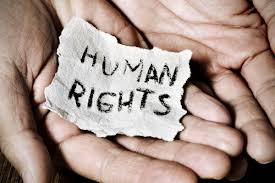
Human rights and equality are of the utmost importance to me. I have a passion for addressing and advocating for justice. I believe that all of my clients, despite specific backgrounds, deserve these rights. It is essential to understand the cultural, racial, environmental, socio-economical, and social discrimination within our societal and governmental structure. I will continue to listen to my clients’ experiences, research the extent and connections of prevalent discrimination and oppression, and work with other professionals to impact positive change. Some ways to make this possible will include staying current on political agendas, legislature, evidence-based practices, and community involvement. I hope to inspire others with my passion so that I can exhibit leadership for justice and equality for my clients.
3.1: Demonstrate leadership in advocating for human rights, social, economic, and environmental justice.
Course Evidence: During my Trauma Foundation class, I viewed the movie, The Accused, and completed an Analysis and Reflection Paper. The paper required critical thinking skills to discuss the social issue of rape and violence against women. It included my personal analysis and evidence-based literature that confronts the adverse effects experienced by rape survivors. Included are conformity studies to explain bystander conformity, mitigating factors, and gender discrimination that influence the rape culture that normalizes this type of violence and disregards the consequences for women. I spent time researching empirical studies uncovering factors influencing these social issues. I also provide recommendations for community resources and policy changes that could provide justice and safety for women.
Field Evidence: I provided an intake diagnostic assessment with a client that did not have any income or insurance to cover services. He was in need of both intensive individual therapy and medication management. I worked with Omni to connect the client to a sliding pay agreement that he could afford since some family members were assisting him financially. I also helped him to apply for social security disability benefits due to his mental health diagnosis that interfered with his ability to secure stable employment.
Additional Evidence: I showed leadership in advocating for a foster child that had never been granted her rights of participating in the team meetings that make decisions about her life, despite foster care policy stating she must be invited to attend each meeting. My advocacy started by contacting her Guardian ad litem and upper management representatives of both Omni Visions and the Department of Children Services. The foster youth was able to start attending these meetings and having an active role in her major life decisions.
3.2: Design and implement social action strategies.
Course Evidence: I collaborated with a group of colleagues to create a nonprofit organization proposal plan in my Advanced Administrative Practice: Administrative and Leadership Skills course. My group created the organization, RISE, an independent living organization for foster youth aging out of the Tennessee foster care system. This population often ages out of the system lacking the resources and support needed for a successful transition into independent adulthood. Statistics show that foster youth are at high risk of incarceration, substance addiction, homelessness, poverty, unplanned pregnancies, and sex trafficking in the immediate years following their eighteenth birthday. RISE is an organization that offers stable individual and family housing units, independent living skills classes, case management, mental health services, and educational advocacy. The RISE organization focused on both macro and micro perspectives to its approach in helping this population.
Field Evidence: I recruited other members of a child’s team to design and implement a social action strategy. I joined the youth’s lawyers and DCS workers in court to provide testimony and documentation in the request of allowing the child to have visitation with a former caregiver in which she formed a familial attachment. The child had asked for visitation with this former caregiver for over a year but was continuously denied by one DCS worker without proper justification. Part of the social action strategy was to utilize the child’s rights per DCS policy in being present for meetings and court hearings so that she could have an active input in decisions affecting her life and permanency.
Additional Evidence: During my Advanced Policy course, my group project focused on repealing the Tennessee Protest Law. One component of this project was to create a social advocacy strategy. The advocacy coalition framework model influenced this advocacy plan. The group wanted to educate and spread awareness of the discrimination this law created and the restriction of some Tennesseans’ basic human rights. We created this action plan to include a coalition of other supporters motivated to fight for social justice.